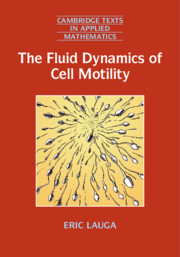Book contents
- Frontmatter
- Dedication
- Contents
- Preface
- Part One Fundamentals
- Part Two Cellular Locomotion
- Part Three INTERACTIONS
- 10 Swimming Cells in Flows
- 11 Self-Propulsion and Surfaces
- 12 Hydrodynamic Synchronisation
- 13 Diffusion and Noisy Swimming
- 14 Hydrodynamics of Collective Locomotion
- 15 Locomotion and Transport in Complex Fluids
- References
- Index
14 - Hydrodynamics of Collective Locomotion
from Part Three - INTERACTIONS
Published online by Cambridge University Press: 09 September 2020
- Frontmatter
- Dedication
- Contents
- Preface
- Part One Fundamentals
- Part Two Cellular Locomotion
- Part Three INTERACTIONS
- 10 Swimming Cells in Flows
- 11 Self-Propulsion and Surfaces
- 12 Hydrodynamic Synchronisation
- 13 Diffusion and Noisy Swimming
- 14 Hydrodynamics of Collective Locomotion
- 15 Locomotion and Transport in Complex Fluids
- References
- Index
Summary
In this fourteenth chapter we turn to the collective dynamics of cell populations such as bacterial colonies. Specifically, we use the results from Chapters 9 and 10 on hydrodynamic interactions to adapt the discrete and continuum frameworks introduced in the previous chapter to the case of collective cell locomotion. Swimming cells create flows, which advect and rotate neighbouring organisms, and since the flow induced by each cell depends on its location and orientation, this coupling leads to complex nonlinear swimming dynamics. In the discrete case, we derive a first-principle model of cells interacting in the dilute limit, demonstrate the different ways in which two swimming microorganisms affect each other hydrodynamically, and show how the model can be used to explain clustering instabilities of swimming algae. We then develop a continuum approach coupling the dynamics of the fluid with the distribution in position and orientation of the cell population. After relating the model to alternative phenomenological descriptions based on symmetry arguments, we use this continuum framework to capture collective cell instabilities.
Keywords
- Type
- Chapter
- Information
- The Fluid Dynamics of Cell Motility , pp. 291 - 314Publisher: Cambridge University PressPrint publication year: 2020

